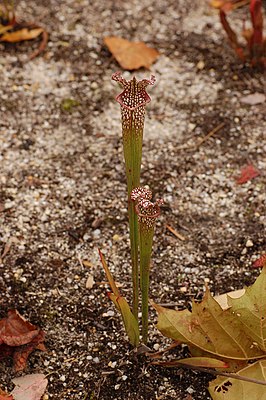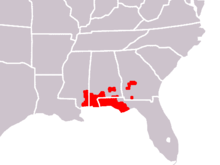White pitcher plant
| White pitcher plant | ||||||||||||
|---|---|---|---|---|---|---|---|---|---|---|---|---|

White pitcher plant ( Sarracenia leucophylla ) |
||||||||||||
| Systematics | ||||||||||||
|
||||||||||||
| Scientific name | ||||||||||||
| Sarracenia leucophylla | ||||||||||||
| Raf. |
The White pitcher plant ( Sarracenia leucophylla ) is a carnivorous plant from the family of Pitcher plants (Sarraceniaceae). The species is native to the southeastern United States.
description
The creeping rhizomes are up to 3 centimeters thick. The upright leaves , the tubes, reach heights of up to 120 centimeters and are finely hairy on the outside. The coloration is very variable, as a rule the tubes are green in the lower part, in the section immediately below the opening and on the lid pure white with more or less strong green or red veins . The lid is slightly arched towards the corrugated edge. The white pitcher plant occasionally forms real phyllodes in winter , but mostly only phyllode-like tubes with stunted lids and tubes. A unique feature within the genus is the formation of tubes twice during the year, namely once in spring and once in late summer / early autumn.
The flowering period extends from the beginning of March to the end of April. The stems of the inflorescences, with a reddish tinge at the upper end, are usually as large as the tubes. The flowers, measuring 4 to 7 centimeters in diameter, smell sweet. The bracts and sepals are dark red to chestnut brown. The petals are light red to brown, 3 to 5 inches long and buckle-shaped with rounded ends. The stamen is often red, the pistil umbrella-shaped, tomentose on the outside and often tinged with red. Style and ovary are more or less red. The fruit is a capsule that opens from behind .
distribution
The white pitcher plant is native to the USA, more precisely from southwest Georgia over the Florida Panhandle and southern Alabama to the extreme southeast of Mississippi . The plants are found in pine savannah and marsh areas , mostly on sandy peat soils and form large stands, many of which are increasingly disappearing.
Systematics and botanical history
The species was first described in 1817 by Constantine S. Rafinesque-Schmaltz , the species name comes from the Greek and means something like "white-leaved". A synonym that has been used for a long time is Sarracenia drummondii Croom .
proof
- ^ A b c d Stewart McPherson: Pitcher Plants of the Americas. The McDonald & Woodward Publishing Company, Blacksburg VA 2007, ISBN 978-0-939923-74-8 , p. 230 ff.
- ^ A b c d Donald E. Schnell: Carnivorous Plants of the United States and Canada. 2nd edition. Timber Press, Portland OR 2002, ISBN 0-88192-540-3 , p. 212 ff.
Web links
- Sarracenia leucophylla inthe IUCN Red List of Threatened Species 2013.1. Posted by: Schnell, D., Catling, P., Folkerts, G., Frost, C., Gardner, R, 2000. Retrieved September 7, 2013.

